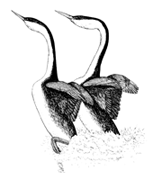Papers in the Biological Sciences
Date of this Version
April 1987
Document Type
Book Chapter
Abstract
Loons, grebes, and auks comprise a rather large number of species of aquatic diving birds that are fairly unfamiliar to most people, inasmuch as they tend to spend much of their time well away from shore and, when approached on the water, usually dive inconspicuously and reappear a considerable distance away. Thus in many areas grebes, simply called "helldivers," are often confused with coots or even diving ducks. Many people know loons only by their wild, penetrating cries and romantically associate them with northern woods and lakes, while auks are symbolic of arctic coastal cliffs. But ornithologists can find fascinating examples of convergent or parallel evolution in avian locomotory and foraging behaviors among these bird groups. They also offer a host of problems of more general ecological and behavioral interest to biologists. Nevertheless, all these groups have been largely neglected in terms of their comparative biology, and not a single inclusive book has dealt with them since Bent's 1919 monograph on their "life histories."
The relative evolutionary relationships among these three groups of diving birds have been a source of continuing controversy, which has not slackened but indeed has intensified as more recent information has become available. There are, to be sure, many similarities that unite each of the three groups with one or both of the other two groups, but there are also substantial numbers of unique or nearly unique characteristics exhibited by each of the three.



Comments
From Diving Birds of North America (1987) by Paul A. Johnsgard. Copyright © 2007 Paul Johnsgard. Cite this work as: Paul Johnsgard, Diving Birds of North America (Lincoln, Nebraska: University of Nebraska Press, 1987; University of Nebraska–Lincoln Libraries, 2008 [ebook edition]).